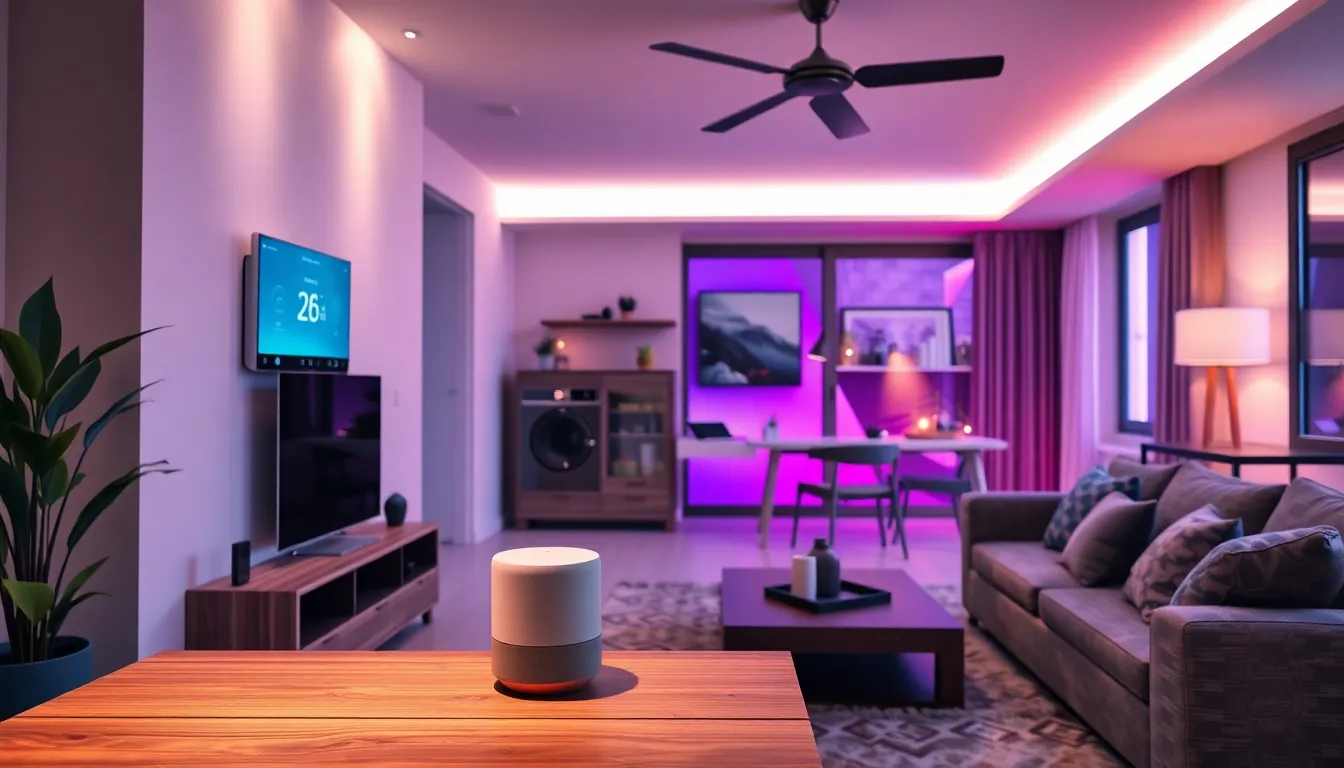Table of Contents
ToggleThe concept of a tech-enabled home is transforming the way people live, making everyday tasks simpler and more efficient. With advancements in smart technology, homeowners now have the power to control everything from lighting to security systems at their fingertips. This integration of technology not only enhances convenience but also promotes energy efficiency and safety.
As more devices connect to the Internet of Things (IoT), the dream of a fully automated home becomes a reality. Imagine adjusting your thermostat or locking your doors remotely, all while monitoring your energy consumption. This article explores the latest innovations in tech-enabled homes and how they’re reshaping modern living, making homes smarter, safer, and more sustainable.
Overview of Tech-Enabled Homes
Tech-enabled homes leverage advanced technology to enhance living experiences. Homeowners benefit from seamless control over systems like lighting, climate, and security through devices connected to the Internet of Things (IoT).
Key Features of Tech-Enabled Homes
- Smart Lighting: Automated lighting systems adjust brightness and color based on time of day or occupancy.
- Smart Security: Security cameras, doorbell cameras, and smart locks provide real-time monitoring and remote access, ensuring safety.
- Smart Thermostats: Devices learn user preferences and optimize energy consumption, resulting in cost savings.
- Voice Assistants: Virtual assistants help manage home functions through voice commands, streamlining everyday tasks.
- Home Entertainment Systems: Integrated audio and video systems create immersive experiences with simple controls from various devices.
Benefits of Tech-Enabled Homes
- Convenience: Smart automation simplifies daily tasks, enabling users to manage their homes effortlessly.
- Energy Efficiency: Technologies reduce energy consumption, contributing to lower utility bills and environmental sustainability.
- Enhanced Security: Real-time alerts and monitoring enhance peace of mind against potential threats.
Trends in Tech-Enabled Homes
- Integration: Increased compatibility among devices fosters a unified home ecosystem.
- AI and Machine Learning: Intelligent systems personalize experiences by learning user habits and preferences.
- Sustainability: Environmentally friendly technologies promote sustainable living through energy conservation and waste reduction.
Tech-enabled homes represent a significant evolution in how individuals interact with their living spaces. With ongoing innovations, these homes continue to transform daily living into a more efficient, secure, and enjoyable experience.
Benefits of Tech-Enabled Homes

Tech-enabled homes provide significant advantages that enhance daily living experiences through smart technology. These advantages encompass improved security measures, energy efficiency, and increased convenience.
Enhanced Security Features
Enhanced security features offer homeowners peace of mind. Smart security systems include cameras that provide real-time monitoring and alerts for unusual activities. Smart locks allow remote access control, enabling users to grant entry to guests or service personnel without being physically present. Furthermore, integrated alarm systems can notify homeowners instantly of breaches or emergencies, ensuring a proactive approach to home safety.
Energy Efficiency and Management
Energy efficiency and management represent critical benefits of tech-enabled homes. Smart thermostats adjust heating and cooling based on occupancy patterns, optimizing energy usage and reducing utility costs. Smart appliances, like refrigerators and washing machines, operate during off-peak hours to take advantage of lower energy rates. Additionally, automated lighting systems reduce energy consumption by utilizing sensors to turn lights off in unoccupied rooms, contributing to overall sustainability.
Convenience and Comfort
Convenience and comfort redefine home living through automation. Smart lighting systems allow homeowners to control brightness and color temperature via mobile apps or voice commands, tailoring the ambiance to specific preferences. Voice-activated assistants simplify daily tasks, enabling users to manage schedules, control devices, and access information hands-free. Integrated home entertainment systems provide seamless experiences, allowing for easy streaming and control across all devices within the household.
Popular Technologies in Tech-Enabled Homes
Tech-enabled homes utilize a variety of technologies to enhance living experiences through automation, convenience, and efficiency. Key technologies that define these homes include smart home hubs, home automation systems, and smart appliances.
Smart Home Hubs
Smart home hubs serve as central points for controlling connected devices. They enable seamless communication between various technologies, allowing homeowners to manage lighting, security, and climate with ease. Popular options include Amazon Echo, Google Nest Hub, and Samsung SmartThings. These hubs support numerous protocols such as Zigbee and Z-Wave, facilitating device integration across brands. Users can control all devices through a single app or voice command, simplifying home management.
Home Automation Systems
Home automation systems enhance the functionality of tech-enabled homes by automating daily tasks. This technology allows users to schedule events, such as adjusting thermostats or turning lights on and off at set times. Integration with security systems provides automated alerts for unusual activity. Companies like Honeywell and Ring offer robust systems that improve safety and convenience. Customizable settings enable tailored experiences, accommodating individual preferences and routines.
Smart Appliances
Smart appliances contribute to energy efficiency and convenience in tech-enabled homes. These appliances, such as refrigerators, washing machines, and ovens, can be controlled remotely and programmed for optimal performance. Brands like LG, Samsung, and Whirlpool create smart appliances that provide usage insights and alerts. For example, smart refrigerators may send notifications when groceries expire, while smart ovens can be programmed to preheat or adjust cooking times remotely. Such technology streamlines household routines and promotes sustainable energy practices.
Challenges and Considerations
Tech-enabled homes offer multiple advantages; however, they also present challenges that homeowners must address.
Privacy and Security Concerns
Privacy and security pose significant issues for tech-enabled homes. Connected devices often collect personal data, making them potential targets for cyberattacks. Smart cameras and voice assistants, while convenient, risk unauthorized access if not properly secured. Homeowners should prioritize using robust passwords and keep software updated to reduce vulnerabilities. Implementing network encryption and utilizing secure Wi-Fi protocols enhances protection against potential breaches. Regular audits of security settings also ensure that privacy remains protected amid evolving technology.
Initial Costs and Investment
Initial costs associated with tech-enabled homes can be considerable. Smart devices and systems typically require upfront investment, which can deter some homeowners. Prices vary widely, depending on features and brands. For example, a smart thermostat may cost between $100 to $250, while comprehensive home automation systems can exceed several thousand dollars. Additionally, installation fees may apply for more complex setups. Despite the initial expenditure, homeowners often recoup costs through energy savings and increased property value over time. Planning budgets effectively and considering long-term benefits before investing remains essential.
Future Trends in Tech-Enabled Homes
Tech-enabled homes continue to evolve, driven by innovative technologies and changing consumer demands. The following trends are expected to shape the future landscape of smart living:
- Advanced AI Integration
Advanced AI algorithms learn user preferences, creating personalized experiences that adapt in real-time. Intelligent home systems analyze patterns to optimize energy consumption, enhance security protocols, and streamline daily tasks.
- Increased Interoperability
Increased interoperability among devices fosters seamless communication across ecosystems. Enhanced compatibility between various smart devices, regardless of brand, simplifies user management and expands the capabilities of tech-enabled homes.
- Enhanced Sustainability Features
Enhanced sustainability features focus on environmentally friendly technologies. Smart energy management systems and automated energy-saving features reduce waste and promote eco-friendly living. Integration with renewable energy sources, such as solar panels, becomes standard practice.
- Health Monitoring Technologies
Health monitoring technologies integrate into home systems, promoting well-being and safety. Smart air quality monitors detect pollutants, while wearables track physical health metrics, alerting homeowners to potential health concerns within their environment.
- Voice and Gesture Control Advancements
Voice and gesture control advancements improve user interaction with home systems. Cutting-edge recognition technologies ensure accurate responses to commands and gestures, creating intuitive user experiences.
- Improved Data Privacy Solutions
Improved data privacy solutions address ongoing security concerns. Encryption technologies and robust privacy tools become standard features, assuring users that their data remains secure against potential breaches.
- Augmented Reality Applications
Augmented reality applications enhance the smart home experience, offering immersive ways to interact with home environments. Users can visualize settings and control features through AR interfaces, providing a unique perspective on home management.
- Smart Home Ecosystems
Smart home ecosystems grow more comprehensive, incorporating diverse technologies. Systems seamlessly connect lights, appliances, security, and entertainment, creating cohesive environments that reflect user lifestyles.
These trends underscore the dynamic nature of tech-enabled homes, presenting exciting opportunities for integrating technology into daily living. The path forward involves a deeper commitment to enhancing home automation, security, sustainability, and user experience.
Tech-enabled homes are redefining modern living by merging convenience with innovation. As homeowners embrace smart technologies they enjoy enhanced security and energy efficiency while simplifying daily routines. The integration of AI and IoT continues to push the boundaries of what’s possible in home automation.
While challenges such as privacy concerns and initial investment costs exist the long-term benefits often outweigh these drawbacks. With advancements in device connectivity and sustainability features tech-enabled homes not only elevate comfort but also contribute to eco-friendly living.
As the landscape of smart homes evolves it’s clear that the future holds exciting possibilities for individuals looking to enhance their living spaces. Embracing these technologies can lead to a smarter safer and more efficient home environment.









